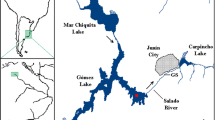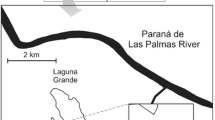Abstract
Extremely high abundance of Asplanchna priodonta led to a decline in the population of the preferred food species, Keratella cochlearis and subsequently, to the extinction of the predator population. Kellicottia longispina was obviously favoured by the predatory losses of the Keratella. Thus, the interactions between Asplanchna and Keratella influenced the zooplankton community structure.
Similar content being viewed by others
References
Dumont, H. J., 1977. Biotic factors in the population dynamics of rotifers. Arch. Hydrobiol. Beih. 8: 98–122.
Edmondson, W. T., 1965. Reproductive rate of planktonic rotifers as related to food and temperature in nature. Ecol. Monogr. 35: 61–111.
Edmondson, W. T., 1977. Population dynamics and secondary production. Arch. Hydrobiol. Beih. 8: 56–64.
Hofmann, W., 1975. The influence of spring circulation on zooplankton dynamics in the Plußsee. Verh. int. Ver. Limnol. 19: 1241–1250.
Krebs, C. J., 1972. Ecology. Harper & Row, N.Y., Evanston, San Francisco, Lond. 694 pp.
Pourriot, R., 1977. Food and feeding habits of Rotifera. Arch. Hydrobiol. Beih. 8: 243–260.
Author information
Authors and Affiliations
Rights and permissions
About this article
Cite this article
Hofmann, W. Interactions between Asplanchna and Keratella cochlearis in the Plußsee (north Germany). Hydrobiologia 104, 363–365 (1983). https://doi.org/10.1007/BF00045992
Issue Date:
DOI: https://doi.org/10.1007/BF00045992




